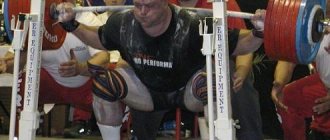People who go from regular gym goers to powerlifting enthusiasts soon realize that without a specific program, they will not shine in this sport. Powerlifting requires you to be in peak physical condition on competition day if you want to be successful. This means that you must strictly follow the powerlifting cycle. In this article, we'll walk you through a basic powerlifting cycle and present a program you can follow to overcome any strength plateau.
Mesocycles, microcycles and macrocycles
First of all, you need to become familiar with the different powerlifting cycles:
- Microcycle
- Mesocycle
- Macrocycle
Microcycle: This is a week-long program.
Mesocycle: People often think that mesocycles are the same as training months. But mesocycles can last either two or twelve weeks. But usually they last from four to eight. Mesocycle is a period when you aim to acquire a new skill or achieve a certain goal.
Macrocycle: This covers the entire training program and can last from twelve weeks to several years. For example, if you were an Olympic athlete, your macrocycle would last four years (assuming that competition is your priority). For powerlifting, the average macrocycle is sixteen weeks: this is the period between competitions.
Classic microcycle
| Monday | Tuesday | Thursday | Saturday |
| bench press | squat | bench press | traction |
In principle, you don’t have to tie this microcycle to the days of the week, the main thing is to follow the “press-squat-press-deadlift” sequence, and the rest time can be anything up to full recovery.
Pros of this microcycle:
- this microcycle allows you to fully recover (which is especially good for heavyweights)
- allows you to use a wider range of additional exercises
- minimal impact of “disruptions” on the training process as a whole
Minuses:
- squats and deadlifts, regardless of intensity, are performed no more than once a week
I recommend using the “Classic Cycle” to absolutely everyone.
Conjugate, linear and wavy
There are three types of periodization that powerlifters use. Most programs combine these three types. We will try to explain everything as clearly as possible.
Conjugate Type: The idea behind conjugate periodization is that you perform the three main exercises (bench press, deadlift and squat) at different angles. You constantly change the exercise slightly. One week you do the bench press with a medium grip, the next week you do the bench press with a close grip. Did you get the point? Each microcycle will be different.
Linear: The exercises remain the same in each microcycle, but you aim to increase the intensity: this can be achieved by increasing the number of repetitions or increasing the weight. The volume may also increase.
Waveform: The exercises remain the same in each microcycle, but the repetitions and load constantly change with each workout. However, the total volume remains the same.
Muscle gain
To gain muscle mass, it is necessary to create such adaptive processes in muscle tissue that will cause its growth. Intensity - 50-70% of the 1RM (ultimate maximum) with the appropriate number of repetitions (from 10 to 6) are most preferable, speed is also important; the effect on a certain type of fiber depends on the speed (there is speed - white ones are “loaded”, no speed - “ loading" red ones).
At this stage, the athlete must sharply increase the calorie intake and the percentage of protein in his diet.
Improving the technique of performing a movement Any technique has the right to life, but there are several postulates that must be used religiously...
Squats
- The back should be straight
- The back should deviate minimally from the vertical
- Your knees should not move forward too much
- The pelvis should not “go” back too much
- Increased dynamics leads to increased returns from overalls and bandages
Bench press
- Maximum deflection in the lower back ensures minimal bench press amplitude
- Bringing the shoulder blades together allows you to reduce the amplitude and increase the rigidity of taking the barbell to the chest
Traction
- The back should be straight
- In the initial phase of the movement, only the legs should work
Tips for competition participants
If you want to peak in competition, then you need your program to be at least linear , otherwise you won't be able to lift heavier weights.
Perhaps the most underrated part of the powerlifting foundation cycle is the pre-contest week, during which many recreational lifters train as normal. This is a big mistake. If you continue to increase the intensity in the last two weeks before the competition, you will not be able to perform at your best in the competition.
Peak intensity should be four weeks before the event. Next week you should reduce the volume by halving the number of sets you perform per exercise. But keep in mind that you can maintain or even increase the weight you use. This way, you'll be lifting heavier weights, but doing half as many reps.
Two weeks before the competition, you need to reduce the weight and reduce the number of exercises performed, concentrating on the main ones. In the last week you also need to halve your weight. This will help you avoid fatigue without losing your fitness and fitness level.
Powerlifting Cycling Stage #3
The duration of the final stage is about ten weeks. The athlete must be given the following tasks:
- Reaching the peak of your strength;
- Increased strength indicators;
- Elimination of bottlenecks;
- Increasing the mobility of ligaments and joints, as well as speed and strength indicators.
To accomplish all of the above tasks, the athlete must increase neuromuscular efficiency or, in other words, increase the mobilization of motor units. To achieve this goal, the following should be done:
- The training intensity should be more than 90% of the maximum load.
- Introduce into the training program exercises to develop explosive strength, for example, jumping with weights.
- Electro-muscular stimulation.
- Include isokinetic training in your training program.
The intensity of training at the final stage should be from 90 to 100% of the maximum maximum.
It should be noted that to calculate the intensity, you should focus on the previous maximum, and not the new one. If an athlete decides to set a new personal best in the gym, then we can assume that he has already performed in competitions, since achieving positive results after this will be very problematic.
In the third stage, which is cycling training in powerlifting, the athlete must reach the peak of his strength form, while maintaining psychological motivation before the competition.
An interesting and informative description of cycling in this video:
How to train with this program using macro-periodization?
In general, when is the best time to start using this type of periodization? => When your working weights have stalled and are not moving at all (i.e. when you can no longer progress the load).
Well, for example: your bench press of 100 kg is no longer doing any good, and accordingly, without progression of loads, muscle growth will stop. What to do? Where is the exit? The only way out is to start using macro-periodization.
To do this, we reduce the workload to 50-60% (i.e. the weights become negligible), the number of sets and repetitions as usual (ps I usually recommend 4 sets of 6-12 repetitions).
How does this all look on our diagram?
Legs
- Squats 4x8-10 (80kg)
- Bench leg press 3x8-10 (200kg)
- Seated leg extension 3xMAX (80kg)
- Calf raises, standing 3x8-10 (100kg)
Let's say your strength at the moment is as I indicated in parentheses for each exercise just above in red. If we train according to macro-periodization, then we will lose as much as 50-60% (i.e. to a very meager amount) and begin to work slowly.
Week #1.
- Squats 4x8-10 (40kg)
- Bench leg press 3x8-10 (80kg)
- Seated leg extension 3xMAX (40kg)
- Calf raises, standing 3x8-10 (50kg)
Do you see? We have reduced the load by almost two. The weights are tiny for us. But that's how it should be. This is the whole point.
Week #2.
- Squats 4x8-10 (42kg)
- Bench leg press 3x8-10 (82kg)
- Seated leg extension 3xMAX (45kg)
- Calf raises, standing 3x8-10 (52kg)
Do you see? The load has already increased slightly. Those. for example, in a squat it was 40 kg, it became 42. 2 kg = this is the progression of the load.
Week #3.
- Squats 4x8-10 (45kg)
- Bench leg press 3x8-10 (85kg)
- Seated leg extension 3xMAX (48kg)
- Calf raises, standing 3x8-10 (55kg)
It increased again. … etc. we are progressing little by little.
Week... let's say number 20
Let’s say it’s week 20, yours may be some other week (I blurted it out at random).
This is the same week that we jumped from a long time ago (when we started using macro-periodization).
Those. we have reached our previous working scales. See below:
- Squats 4x8-10 (80kg)
- Bench leg press 3x8-10 (200kg)
- Seated leg extension 3xMAX (80kg)
- Calf raises, standing 3x8-10 (100kg)
Do you see? We have reached our previous scales. What's next?
Then the most interesting thing begins, you finally get a kick out of training (you really want to, because light weights don’t work), you break through (break through your natural physiological ceiling), i.e.:
Week #21.
- Squats 4x8-10 (82kg)
- Bench leg press 3x8-10 (205kg)
- Seated leg extension 3xMAX (85kg)
- Calf raises, standing 3x8-10 (105kg)
Week #22.
- Squats 4x8-10 (85kg)
- Bench leg press 3x8-10 (207-210kg)
- Seated leg extension 3xMAX (88-90kg)
- Calf raises, standing 3x8-10 (110kg)
And then we make our way and make our way, i.e. The training is already hard, we have surpassed our previous results, and continue to surpass further and further.
Ps remember how much you trained (progressing little by little) to achieve your results, i.e. in our scheme this is week No. 1. – week No. 20. At the twentieth week we reached our previous scales.
This period of time must be remembered. What is it for? => So that you have a guideline for how hard to train. Those. Let’s say this all lasted 4 months for us (i.e., for 4 months we trained easily, gradually approaching our weights). Now that we've gotten to these weights, we've been training hard for 4 months. It's clear? If you trained easily not 4, but 3, then you train hard for 3 months... I think the point is clear.
That's it, my friends. This is macro-periodization. I hope I explained everything clearly.
Well, we move on, finally moving on to micro-periodization.
Development of a powerlifting cycle
Below is an example of organizing a training cycle for powerlifting. I emphasize that this training program is just an example and is by no means the only program using periodization.
- Monday - Squats;
- Wednesday - Bench Press;
- Friday - Deadlift;
- Saturday - Light bench press workout (optional).
You need to know the maximum weight you can use for a set of four, three, two or one repetition. Of course, the most accurate result can only be obtained from a set of one repetition, but it is quite possible to calculate the maximum one-time achievement using the maximum achievement in a set of 2, 3, 4, 5 repetitions. Here's the formula:
Take your best weight and multiply it by this number.
- 2 reps - ? x 1.06;
- 3 reps - ? x 1.12;
- 4 reps - ? x 1.15;
- 5 reps - ? x 1.18.
You will receive your maximum one-time achievement.
Organization of the macrocycle
When constructing a macrocycle, one should be guided by the following postulates:
- only periodic increase in load leads to progress
- Constant progression of load leads to overtraining
- after reaching the peak of strength there is always a decline
Bench press
1. (50%-10)-5 2. (54%-9)-5 3. (58%-8)-5 4. (62%-7)-5 5. (66%-6)-5 6. (70%-5)-5
Organization of the macrocycle in the second phase (gaining strength, increasing endurance, improving speed and strength qualities, 8 weeks). To gain strength, sinusoidal macrocycling should range from 70% to 90% intensity with the number of repetitions from 3 to 6. However, taking into account the goal of increasing strength endurance, the number of approaches should be quite large - up to 8!
An example of a macrocycle for the development of strength and strength endurance.
Bench press
1. (70%-6)-3 2. (73%-5)-4 3. (76%-4)-5 4. (79%-4)-5 5. (82%-3)-6 6. (78%-4)-5 7. (75%-5)-5 8. (72%-6)-4 9. (76%-4)-5 10. (80%-3)-6
Organization of the macrocycle in the third phase (reaching peak strength, gaining strength, 10 weeks). To gain strength, sinusoidal macrocycling should range from an intensity of 75-80% to 90-95% and higher with the number of repetitions from 1 to 5. However, taking into account the task of increasing strength endurance, the number of approaches should be quite large - up to 8!
An example of a macrocycle for the development of strength and the release of peak strength.







